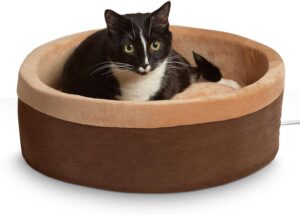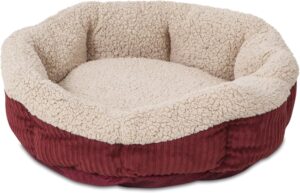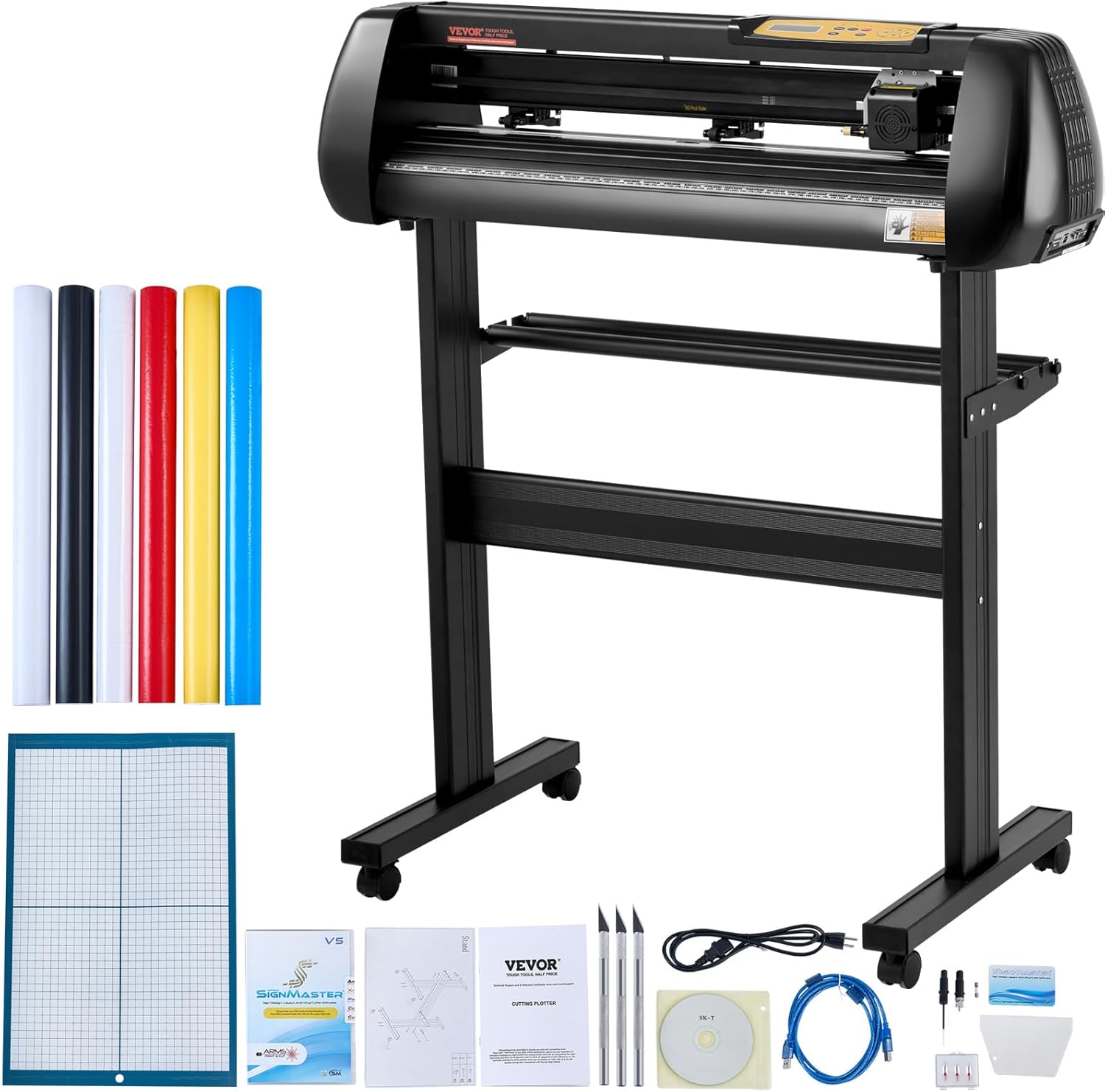You know that feeling when your cat curls up on your laptop keyboard or sprawls across your heating vent? They’re not just being annoying—they’re chasing warmth. And honestly, can you blame them?
I’ve watched my cat, Luna, migrate around the house like a heat-seeking missile every winter. She’d squeeze behind the TV, perch on the cable box, even try to burrow under my morning coffee mug. That’s when I realized: she needed her own heated spot.
Heated cat beds changed everything. No more laptop invasions. No more fur-covered electronics. Just one very satisfied, very warm cat.
Let me walk you through the best options I’ve found, what actually matters when buying one, and how to pick the perfect heated bed for your furball.
Quick Pick: Our #1 Recommendation
K&H Pet Products Thermo-Kitty Bed
This is the one I bought for Luna, and it’s been running strong for two years. It heats up to your cat’s normal body temperature (around 102°F), uses only 4 watts of power, and has a removable, machine-washable cover.
The bed stays warm 24/7, but it’s not hot—just perfectly cozy. At around $45, it’s the sweet spot between quality and price.

Best For: Cats who love constant, gentle warmth
This is the gold standard for heated cat beds. I’m not just saying that—it’s the one currently hosting my cat as I write this.
The bed uses an internal heating element that warms to your cat’s body temperature. It’s not a blast of heat. It’s more like a warm hug that never ends.
Specs:
- Heats to 102°F (your cat’s natural body temperature)
- Uses only 4 watts of electricity (costs pennies per month)
- 20-inch diameter sleeping surface
Pros:
- Machine-washable cover makes cleanup easy
- MET safety certified with steel-wrapped cord
- Works without your cat lying on it (unlike thermal beds)

Best For: Budget-conscious cat parents who want temperature control
If you want more control over the heat level, this is your pick. It comes with seven temperature settings and an auto-shutoff timer.
I tested this at my sister’s house with her senior cat, Oliver. He’s 14 and has arthritis. The adjustable heat helped soothe his joints on particularly cold nights.
Specs:
- Seven temperature levels (86°F to 131°F)
- Auto shut-off after 1-6 hours
- Waterproof and chew-resistant cord
Pros:
- Extremely affordable (usually under $30)
- Great for cats who get too hot easily
- Timer prevents overheating

Best For: Eco-conscious owners who want zero electricity
This isn’t technically a “heated” bed—it’s self-warming. It uses a layer of mylar material that reflects your cat’s body heat back to them.
No cords. No electricity bills. No worries about leaving it on when you travel.
Specs:
- Reflective mylar lining captures body heat
- 19-inch diameter
- Machine-washable faux lambswool interior
Pros:
- Zero electricity needed
- Perfect for mild climates or spring/fall
- Safer for kittens and young cats

Best For: Outdoor, feral, or barn cats
If your cat spends time outside—or if you’re caring for a feral colony—this is the one. It’s specifically designed for outdoor use.
I bought this for my neighbor who feeds a feral cat family. Even in 20°F weather, those cats had a warm spot to rest.
Specs:
- Heats to 102°F only when your cat lies on it
- Steel-wrapped cord with protective sleeve
- Weather-resistant construction
Pros:
- Pressure-activated (saves energy, stays safer)
- MET listed for outdoor use
- Can be placed inside a shelter or carrier
What to Consider When Buying a Heated Cat Bed
Safety First, Always
Look for beds with MET or UL safety certification. Check that the cord is steel-wrapped or chew-resistant. Your cat might never chew cords, but one time is all it takes.
I also prefer beds with automatic temperature regulation. You don’t want your cat getting too hot, especially if they’re elderly or have health issues.
Temperature Range Matters
Most heated beds warm to 100-110°F. That’s perfect for cats, whose normal body temperature is around 101-102°F.
But some cats run hot. If your cat pants easily or seeks out cold tiles in summer, look for adjustable temperature settings or self-warming beds instead.
Size It Right
Cats love to curl up, but they also like to stretch. Measure your cat from nose to tail base and add a few inches.
For reference, most cats do well with 18-20 inch beds. Larger breeds like Maine Coons need 22-24 inches.
Washability Is Non-Negotiable
Cats shed. They track litter. Sometimes they have accidents. You need a bed with a removable, machine-washable cover.
Trust me. I learned this the hard way with Luna’s first heated bed, which had a permanently attached cover. It lasted three months before it became too gross to save.
Indoor vs. Outdoor Use
Indoor heated beds often aren’t weather-resistant. Outdoor beds need waterproofing, pressure activation, and durable construction.
Don’t use an indoor bed outside. It’s a safety risk and won’t last through one rainy week.
Power Consumption
Most quality heated beds use 4-20 watts. That’s about $1-3 per month in electricity, even running 24/7.
The super cheap beds sometimes use 40+ watts. Check the specs before buying.
Conclusion: Your Cat Deserves to Be Warm
Here’s the thing about heated cat beds: they’re not a luxury. They’re comfort, especially for senior cats, hairless breeds, or any feline who shivers through winter.
Since getting Luna her K&H Thermo-Kitty Bed, she’s stopped her desperate heat-seeking behaviors. No more sitting on my keyboard. No more squeezing behind the refrigerator (yes, she actually did that once).
She just curls up in her bed, purrs like a motorboat, and sleeps. That’s it. That’s the dream.
If you’re still on the fence, start with the K&H Thermo-Kitty Bed. It’s reliable, affordable, and exactly what most cats need. If your situation is different—outdoor cats, multiple cats, or specific temperature needs—one of the other options will work better.
Your cat can’t tell you they’re cold. But watch where they sleep. If they’re hunting for heat, give them a proper warm spot. They’ll thank you with purrs, biscuits, and maybe—just maybe—fewer 3 AM zoomies.
Frequently Asked Questions
Are heated cat beds safe to leave on all day?
Yes, quality heated beds with safety certifications (MET or UL) are designed to run 24/7. They maintain safe temperatures and use steel-wrapped cords to prevent chewing hazards. I leave Luna’s on constantly during winter with zero issues.
How much does it cost to run a heated cat bed?
Most heated beds use 4-20 watts, which costs about $1-3 per month running 24/7. That’s less than a fancy coffee drink. The energy usage is minimal because they’re maintaining warmth, not generating high heat.
Will my cat actually use a heated bed?
Most cats love them instantly, especially older cats or hairless breeds. But some cats need time to investigate. Place the bed in their favorite napping spot and let them discover it naturally. Luna ignored hers for two days, then became obsessed.
Can kittens use heated cat beds?
Young kittens (under 8 weeks) should only use self-warming beds, not electric ones. They can’t regulate body temperature well yet. Once your kitten is older and more mobile, low-temperature heated beds (around 100-102°F) are safe.
What’s the difference between heated and self-warming beds?
Heated beds use electricity to generate warmth. Self-warming beds use reflective material to bounce your cat’s body heat back to them. Heated beds work better in cold climates. Self-warming beds are safer for kittens and use zero electricity.
Do heated beds help cats with arthritis?
Yes! Gentle warmth can soothe arthritic joints and stiff muscles. My sister’s senior cat, Oliver, sleeps noticeably better on his heated pad. Just make sure the bed isn’t too high—arthritic cats need easy access.
How do I clean a heated cat bed?
Remove the cover (if it’s removable) and machine wash it on gentle cycle. Never submerge the heating element in water. Wipe the heating pad with a damp cloth and let it dry completely before reassembling.
Can I use a heated cat bed outdoors?
Only if it’s specifically rated for outdoor use. Indoor beds aren’t weatherproof. Outdoor beds like the K&H Outdoor Kitty Pad have weather-resistant construction and pressure-activated heating for safety.


